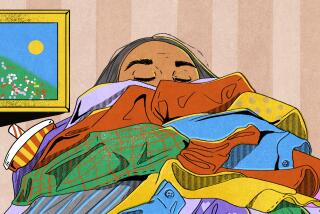Getting Organized Was in the Bag
- Share via
When I was young and very disorganized, a friend showed me how to arrange the paper sacks in my broom closet by opening up one large sack, turning down the top of the bag for reinforcement, and then standing the other bags up inside the first one. Every time I opened that closet door and saw the sack of bags I knew I had control and it made me feel as though I had accomplished something, even if it was trivial.
Twenty years later, I still organize the paper sacks in the same way. And, one at a time, I have learned to give order to each area of my home. We have a plan to take care of unmatched socks, a way to keep the newspapers from taking over and even a simple process for getting the wastepaper baskets emptied for trash day. Organized people gradually set up a series of programs to accommodate every aspect of life.
Other organizers agree with this simplified approach. Alice Fulton and Pauline Hatch of Washington have written a book that emphasizes simplification. They tell how to make a place for everything. “It’s Here . . . Somewhere” (Writer’s Digest Books: $6.95) shows you how to deal . . . once and for all . . . with chronic clutter, lack of space and the irritating lost-and-found pattern in your home. They have an eight-step plan that is easy to apply to any room.
In my opinion, these women are daring in their recommendations. When I flipped through their book, the first thing that caught my attention was: “You may not really need a linen closet. Storing linens in a closet is an extravagant waste of space. In the interest of better space management, get rid of the extra bed linens.” They go on to state that almost every house is built with a linen closet and thus we automatically assume extra bedding is a necessity. With an open mind, consider breaking that tradition.
Here are their three points of logic.
--If you did not use that closet for linens, it would be very valuable for storing other things. If you are really daring, consider only keeping the sheets that are currently on the beds. If you must keep an extra set, lay them flat between the box spring and mattress; people with water beds may need to use a drawer or shelf in the closet. This program also helps simplify laundry. Wash and dry linens and put them back on the bed the same day. No more piles-in-waiting.
--Many home managers feel they can not live with just one design; they want variety. But, once you catch the vision of the reward, perhaps you will entertain the possibility. Most people buy a new set of linens because they want a change. The mind tires of the bedding before the fibers give way. Those shoppers probably use the new sheets more often than the older ones because they still are the newest. The old sheets sit in the linen closet and wait their turn with all the others. We say we like variety, but we usually choose new over old. Would you be able to live with just one set of sheets per bed? Will you start by allowing just two sets per bed? Send the others to the garage for rags or to a charity for someone else to enjoy.
--One argument for hanging onto extra linens is: “If the linens aren’t rotated, they’ll wear out more quickly.” Wearing out is not the issue, especially with modern fabrics and washing machines. Most people quit using the sheets before they wear out anyway.
Take into account the cost of shelf space. Would you pay $10 a year to rent space to keep each pair of extra sheets? A typical family will keep sheets from five to 10 years. No wonder it takes a whole closet to house them and other linens.
The authors recommend: “Turn it (empty closet) into an arts-and-crafts center; keep your sewing machine, supplies and notions there; or create a mini-office.”
Are you looking for a place to keep gift wrappings or scrapbook paraphernalia? Make it into a library or activity center for children or grandchildren who may visit. It could be used to house china and crystal or wine and liquor. You may decide to use it as a pantry or for food storage. The primary principle of things is: “Keep what you need, of the rest be freed.”






